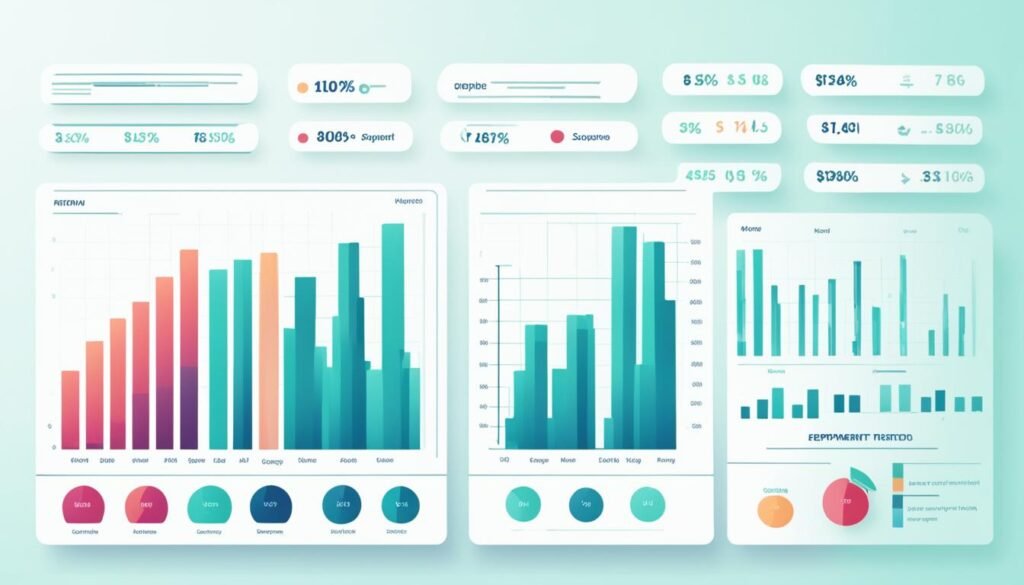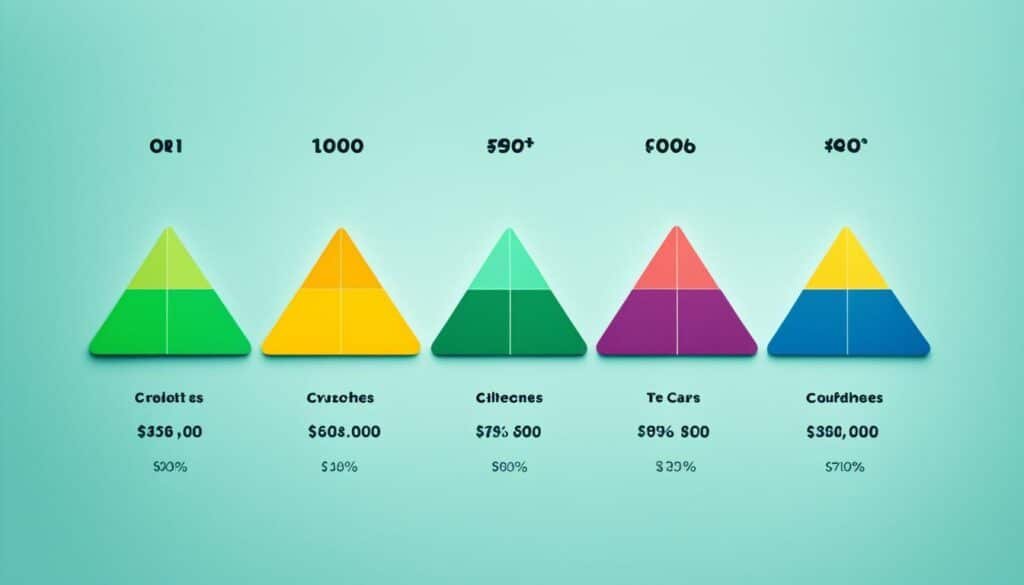Mastering Loan Tenure Selection When it comes to managing loan repayments, choosing the right loan tenure is crucial. The loan tenure, also known as the repayment period, determines the duration over which you will be repaying the loan amount along with the applicable interest rate. It plays a significant role in determining your monthly loan EMIs and the overall cost of the loan.
So, how do you choose the ideal loan tenure that aligns with your financial goals and helps you effectively manage your loan repayment? Let’s explore some key factors and considerations that can guide your decision-making process.
One of the main factors to consider is the interest rate associated with the loan. Higher interest rates may result in larger EMIs and a longer repayment period. On the other hand, lower interest rates can help you repay the loan faster with smaller EMIs.
The loan amount is another important aspect to consider. If you borrow a large sum, opting for a longer repayment period may help distribute the EMI burden over a longer duration. However, keep in mind that a longer tenure may result in higher interest payments over time. On the contrary, if you can manage larger EMIs, choosing a shorter tenure can help you save on interest payments and repay the loan sooner.
Your credit score also plays a significant role in loan tenure selection. A good credit score can facilitate access to loans with lower interest rates and favorable repayment terms. On the other hand, if you have a lower credit score, lenders may offer loans with higher interest rates and shorter repayment periods. Assess your credit score and ensure it aligns with the loan tenure you are considering.
Additionally, it is essential to evaluate your financial goals and current financial situation. If your goal is to become debt-free quickly and save on interest payments, opting for a shorter loan tenure might be ideal. Alternatively, if you prefer lower EMIs and have other financial obligations or investments, a longer tenure may be more suitable.
By carefully considering the repayment period, interest rate, loan amount, credit score, and your financial goals, you can choose the right loan tenure that allows you to manage your loan EMIs effectively and achieve your objectives. Remember, it’s crucial to strike a balance between loan repayment affordability and optimizing your financial resources.
Key Takeaways:
- Choosing the right loan tenure is crucial for effective loan management and optimizing loan EMIs.
- Factors such as interest rate, loan amount, credit score, and financial goals should be considered when selecting the repayment period.
- Higher interest rates may result in larger EMIs, while lower interest rates can help you repay the loan faster with smaller EMIs.
- A longer tenure may distribute the EMI burden over a longer duration, but it can result in higher interest payments over time.
- Your credit score plays a significant role in accessing favorable loan terms and conditions.
Understanding Loan Repayment: Types of Loans
Before delving into loan tenure selection, it’s important to understand the types of loans available. The two main categories are fixed-term loans and credit cards or lines of credit.
Fixed-term loans involve structured repayment with a fixed interest rate and are often taken out for specific purposes. These loans can be either secured or unsecured. Secured loans require collateral, such as a property or vehicle, while unsecured loans do not.
Credit cards and lines of credit, on the other hand, provide revolving credit and flexible repayment options. With revolving credit, you have a set credit limit, and you can borrow and repay as needed. Credit card holders can choose to pay only the minimum amount due each month or pay off the full balance.
Understanding the characteristics of these loan types is crucial in making informed decisions about your loan tenure. Consider the purpose of your loan, your financial situation, and your preferences for repayment flexibility when choosing between fixed-term loans and revolving credit options.
Types of Fixed-Term Loans
Fixed-term loans are often taken out for a specific purpose, such as purchasing a car, financing home renovations, or consolidating debts. Here are some common types of fixed-term loans:
- Car loans
- Home loans
- Personal loans
- Debt consolidation loans
Types of Credit Cards and Lines of Credit
Credit cards and lines of credit offer more flexibility in terms of borrowing and repayment. Here are some common types:
- Traditional credit cards
- Business credit cards
- Home equity lines of credit
- Personal lines of credit
Each type of loan has its own advantages and considerations. Consult with a financial advisor or conduct thorough research to determine which loan type aligns with your financial goals and needs.
Loan Repayment Terminology
Understanding loan repayment involves familiarizing yourself with key terms. These terms play a crucial role in comprehending the dynamics of loan repayment and can aid in making informed decisions about loan tenure selection.
Principal: The principal is the initial amount borrowed from the lender. It represents the total loan amount before interest and other costs are added.
Interest: Interest is the cost charged by the lender for borrowing the money. It is typically expressed as a percentage of the principal and can vary based on factors such as creditworthiness and market conditions.
Term: The term refers to the duration of the loan, or the length of time the borrower has to repay the loan. It is commonly expressed in months or years.
Monthly Payment: The monthly payment is the amount the borrower is required to pay each month to repay the loan. It includes both the principal and interest portions of the repayment.
Amortization: Amortization is the gradual reduction of the loan balance through regular payments. It involves the application of a portion of each payment towards the principal and another portion towards the interest.
“Understanding the principal, interest, term, monthly payment, and amortization is crucial for navigating the complexities of loan repayment and optimizing your loan tenure.”
By having a clear understanding of these terms, borrowers can make informed decisions about loan tenure selection and develop effective strategies for managing their loan repayments.
Next, let’s explore the advantages of utilizing loan repayment calculators as powerful financial tools.

Importance of Loan Repayment Calculators
Loan repayment calculators are essential financial tools that can greatly assist in effectively managing loan repayments. These calculators provide personalized calculations based on various factors such as loan amount, interest rate, and loan term. By utilizing a loan repayment calculator, borrowers can receive accurate and customized information about their loan repayment plan, helping them make informed decisions about loan tenure and optimize their repayment strategy.
One of the key advantages of loan repayment calculators is that they offer personalized calculations tailored to each borrower’s specific circumstances. These calculators take into account factors such as the loan amount, interest rate, and loan term to provide accurate estimates of monthly payments and the total repayment amount. This personalized approach allows borrowers to have a clear understanding of how their loan repayment will unfold, enabling them to plan their finances more effectively.
By using a loan repayment calculator, borrowers can generate an amortization schedule. This schedule provides a detailed breakdown of monthly payments, indicating the portion of each payment that goes towards the principal amount and the interest. This information helps borrowers visualize the progress of their loan repayment and understand how their payments contribute to reducing the outstanding loan balance over time.
Loan repayment calculators also allow borrowers to explore the impact of making extra payments. By inputting additional payment amounts into the calculator, borrowers can see how these extra payments affect their loan repayment timeline and the total interest paid. This feature offers borrowers valuable insights into the benefits of making extra payments, empowering them to make informed decisions about whether to allocate additional funds towards loan repayment.
Furthermore, loan repayment calculators provide a convenient and user-friendly way to conduct financial analyses. Borrowers can experiment with different loan amounts, interest rates, and loan terms to determine the most suitable loan structure for their needs. This flexibility allows borrowers to compare various scenarios and make well-informed decisions about loan tenure, ensuring that their loan repayment aligns with their financial goals.
Overall, loan repayment calculators are powerful financial tools that offer personalized and detailed calculations to borrowers. They enable borrowers to optimize their loan repayment strategy by visualizing the impact of their decisions, such as making extra payments, adjusting loan terms, or selecting different loan amounts. By leveraging the capabilities of loan repayment calculators, borrowers can make informed decisions, effectively manage their loan repayments, and achieve their financial goals.

Tips for Effective Personal Loan EMI Management
Managing personal loan EMIs requires careful planning and financial discipline. To effectively manage your personal loan EMIs, start by assessing your financial health and creating a realistic budget. By evaluating your income, expenses, and financial obligations, you can get a clear picture of your financial standing and determine the affordability of personal loan EMIs.
When assessing your financial health, consider factors such as your monthly income, existing debt obligations, and savings. This evaluation will help you gauge whether taking on a personal loan is a feasible option and if you can comfortably accommodate the loan EMIs within your budget.
Creating a realistic budget is essential. Factor in all your monthly expenses, including rent or mortgage payments, utilities, groceries, transportation, and other daily living costs. By allocating your income appropriately and accounting for unexpected expenses, you can maintain a stable financial position while fulfilling your loan repayment obligations.
It’s important to negotiate favorable loan terms with your lender. This includes both the interest rate and the repayment tenure. By securing favorable loan terms, you can reduce the burden of your loan EMIs and potentially save money in the long run.
Choosing a suitable repayment tenure is another crucial aspect of managing personal loan EMIs efficiently. A longer repayment tenure may result in lower monthly installments, but it also means you will be paying interest for a longer period. On the other hand, a shorter tenure may lead to higher EMIs but can save you money on interest payments. Consider your financial goals, cash flow, and future plans to determine the repayment tenure that aligns with your needs.
Building an emergency fund is a prudent step in managing personal loan EMIs. Unexpected expenses can arise at any time, and having a financial cushion allows you to handle them without compromising your loan repayment commitments. Aim to save at least three to six months’ worth of living expenses as an emergency fund.
Making timely payments is crucial for maintaining a good credit score and avoiding late payment penalties. Set up reminders or automatic payments to ensure you do not miss any due dates. By being consistent and conscientious with your payments, you demonstrate financial discipline and build a positive credit history.
Consider the option of loan prepayment if you have surplus funds. Making additional payments towards your loan principal can help reduce the overall interest burden and shorten the repayment tenure. However, carefully evaluate the terms and conditions of prepayment to ensure it aligns with your loan agreement.

To summarize, managing personal loan EMIs effectively involves assessing your financial health, creating a realistic budget, negotiating favorable loan terms, choosing a suitable repayment tenure, building an emergency fund, making timely payments, and considering loan prepayment options. By following these tips, you can stay on top of your personal loan EMIs and achieve financial stability.
Types of Unsecured Loans and Their Utilization
Unsecured loans offer flexibility and versatility, catering to various financial needs. Let’s explore the different types of unsecured loans and how they can be utilized:
- Revolving loans: These loans provide a line of credit that can be borrowed and repaid multiple times, with interest charged only on the utilized amount. They are ideal for managing ongoing expenses or cash flow fluctuations.
- Term loans: Term loans involve borrowing a fixed amount with a specified repayment period. They are commonly used for one-time expenses, such as purchasing a vehicle or financing a wedding.
- Consolidation loans: These loans are designed to consolidate multiple debts into a single loan, simplifying repayment and potentially lowering overall interest costs.
- Wedding loans: Wedding loans provide funds to cover wedding-related expenses, ensuring the celebration is memorable without straining finances.
- Vacation loans: Vacation loans help finance dream getaways, allowing individuals to create lasting memories without compromising their savings.
- Home renovation loans: These loans enable homeowners to improve their properties, whether it’s remodeling a kitchen or adding another room.
- Top-up loans: Top-up loans are additional funds borrowed on top of an existing loan, providing financial flexibility for various purposes.
- Bridge loans: Bridge loans bridge the gap between the purchase of a new property and the sale of an existing one, ensuring a smooth transition.
- Consumer durable loans: These loans finance the purchase of consumer durables, such as appliances or electronics, allowing individuals to enjoy these products before making full payments.
- Business loans: Business loans provide working capital or funds for expansion, helping entrepreneurs meet their business goals.
- Receivables financing: This financing option allows businesses to leverage their accounts receivable to obtain immediate cash flow, supporting short-term financial needs.
Understanding the different types of unsecured loans and their utilization can guide you in selecting the loan tenure that aligns with your specific financial situation and goals.

Advantages of Revolving Loans and Term Loans
Revolving loans and term loans offer distinct advantages depending on your financial goals and borrowing needs. Understanding the differences between these loan types can help you make an informed decision about which one is more suitable for you.
Revolving Loans:
Revolving loans provide flexibility in repayment and variable interest rates, making them ideal for managing working capital needs or temporary cash crunches. With a revolving loan, you have access to a predetermined credit limit, and you can borrow and repay as needed within that limit. This allows you to have control over your repayments and manage your finances more effectively. The interest rates on revolving loans may fluctuate based on various factors, offering the potential for lower rates when compared to fixed interest rates.
Term Loans:
Term loans, on the other hand, provide fixed interest rates and fixed tenures, making them suitable for long-term investments or financing fixed assets. With a term loan, you receive a lump sum amount upfront, and you repay the loan over a predetermined period in regular installments. The fixed interest rate ensures stability in your monthly payments, allowing for better budgeting and financial planning. Term loans are often used for larger expenses, such as purchasing a home or financing a business venture.
By carefully considering the advantages of revolving loans and term loans, you can select the loan type that aligns with your financial goals and loan tenure selection.
| Advantages of Revolving Loans | Advantages of Term Loans |
|---|---|
|
|
Understanding these advantages will help you determine which loan type is more suitable for your financial goals and loan tenure selection.

Considerations for Unsecured Loan Utilization
When utilizing unsecured loans for specific purposes, there are certain considerations to keep in mind. Different types of loans serve different needs, and understanding how to best utilize them will help you make informed decisions about your loan tenure and repayment strategy.
Wedding Expenses
Weddings can be a significant financial undertaking, and if you’re in need of funds to cover expenses, a wedding loan can be a suitable solution. By securing an unsecured loan specifically for your wedding, you can ensure that you have the funds necessary to create your dream event without compromising your financial stability.
Vacation Expenses
We all need a break every now and then, and if you’re planning a vacation but don’t have the funds upfront, a vacation loan can help you cover the expenses. Whether you’re traveling to a tropical beach or exploring a new city, a vacation loan can provide you with the financing you need to make your trip a reality.
Home Renovation
If you’re looking to make improvements or renovations to your home, an unsecured home renovation loan can give you the financial support you need. Whether it’s a kitchen remodel, bathroom upgrade, or landscaping project, an unsecured loan can help you transform your house into your dream home.
Business Investment
For entrepreneurs and small business owners, unsecured business loans can be a valuable tool for investment in infrastructure or working capital needs. Whether you’re starting a new venture or expanding an existing one, a business loan can provide you with the funds necessary to fuel your growth.
Consolidating Loans
If you have multiple loans with different interest rates and repayment terms, consolidating them into a single unsecured loan can simplify your financial management. By consolidating your loans, you can streamline your repayment process and potentially lower your overall interest costs.
Managing Cash Flow
Unsecured loans can also be used to manage cash flow fluctuations in your personal or business finances. Whether you’re facing unexpected expenses or experiencing a temporary dip in revenue, an unsecured loan can help bridge the gap and stabilize your cash flow.
By considering these factors and understanding how unsecured loans can be utilized, you can determine the most appropriate loan tenure for your specific needs and financial goals. Remember to carefully assess your repayment capacity and ensure that you are comfortable with the terms and conditions of the loan before proceeding. Utilizing unsecured loans strategically can provide you with the financial support you need while effectively managing your cash flow and achieving your goals.
Exploring Personal Loan EMI Management Services
When it comes to effectively managing personal loan EMIs, having the right financial tools and services can make all the difference. That’s where Finnable, a leading financial start-up, comes in. Finnable offers a range of services designed to help individuals manage their personal loan EMIs with ease.
With Finnable’s financial assessment services, you can gain valuable insights into your financial health. Their team of experts will analyze your income, expenses, and financial goals to provide personalized recommendations. This assessment will help you make informed decisions when it comes to managing your personal loan EMIs.
Creating a realistic budget is a key aspect of effective EMI management. Finnable provides guidance on how to develop a budget that aligns with your financial goals and ensures that you can comfortably repay your loan. Their experts will help you prioritize expenses, identify areas where you can save, and create a sustainable financial plan.
Competitive interest rates are another advantage of partnering with Finnable. They understand that interest rates play a significant role in determining your loan EMIs and overall loan affordability. By offering competitive rates, Finnable aims to make loan repayment more manageable and affordable for their customers.
Flexibility is essential when it comes to loan repayment. Finnable offers flexible repayment options that cater to your specific needs. Whether you prefer a shorter loan tenure with higher EMIs or a longer tenure with lower EMIs, Finnable has options that can be tailored to your requirements. This flexibility ensures that you can repay your loan comfortably while staying within your financial means.
Finnable’s loan tenure calculator is a valuable tool that can assist you in planning and optimizing your personal loan repayments. With this calculator, you can input your loan amount, interest rate, and desired tenure to determine the optimal EMI amount and total repayment amount. This helps you make an informed decision about the loan tenure that suits your financial situation.
For those looking to effectively manage their personal loan EMIs, Finnable offers the services and tools needed to ensure a smooth and stress-free experience. From financial assessment services and realistic budget guidance to competitive interest rates and flexible repayment options, Finnable is committed to helping you navigate your personal loan journey with confidence.
Benefits of Trade Receivables Financing
Trade receivables financing provides businesses with valuable benefits, allowing them to effectively manage cash flow and meet short-term fund requirements. This financing option includes factoring and invoice discounting, enabling businesses to leverage their outstanding receivables for financial support.
Factoring involves selling receivables to a specialized company, known as a factor, in exchange for immediate cash. This allows businesses to improve their liquidity and access funds quickly, without waiting for customers to make payments. Factoring provides a solution to short-term fund requirements, helping businesses cover operational costs, seize growth opportunities, or address unexpected expenses.
On the other hand, invoice discounting allows businesses to obtain funds by using their receivables as collateral. This financial arrangement provides working capital based on the value of outstanding invoices, giving businesses the flexibility to maintain control over their collections process while accessing the necessary funds.
One of the primary advantages of trade receivables financing is improved cash flow management. By converting receivables into immediate funds, businesses can ensure a steady stream of working capital, allowing for smoother operations and minimizing the risk of cash flow gaps.
Furthermore, this financing option is particularly beneficial for short-term fund requirements. Businesses often encounter situations where they need quick access to funds, whether to cover unexpected expenses or seize growth opportunities. Trade receivables financing provides a timely solution to these short-term fund needs, offering businesses the flexibility and agility to respond to evolving market conditions.
Also Read:- What Are The Top Strategies For Maximizing Agricultural Loans?
Combining the advantages of factoring and invoice discounting, trade receivables financing presents businesses with a versatile solution for their financial requirements. This financing option allows businesses to optimize their liquidity, effectively manage cash flow, and successfully navigate short-term fund needs.
Benefits of Trade Receivables Financing:
- Improved cash flow management
- Quick access to funds for short-term requirements
- Enhanced liquidity and working capital
- Flexibility to seize growth opportunities
- Stronger financial stability
By understanding the benefits of trade receivables financing, businesses can make informed decisions about utilizing this financial option to support their operations and achieve their short-term financial goals.
Conclusion
Mastering loan tenure selection is essential for effective loan management and optimized loan EMIs. By carefully considering factors such as repayment period, interest rate, loan amount, and your financial goals, you can choose the right loan tenure that aligns with your needs. A solid loan repayment strategy should be developed based on these considerations.
To make informed decisions about loan tenure, utilize loan repayment calculators that provide personalized calculations based on your specific loan details. Financial assessment services can also provide valuable insights into your financial health and offer realistic budget guidance. By leveraging these tools and expert guidance, you can effectively navigate loan tenure selection and achieve your financial goals.
Having a comprehensive understanding of loan tenure selection allows you to optimize your loan EMIs and gain financial stability. Take advantage of these resources and develop a loan repayment strategy that sets you on the path to financial success. Mastering loan tenure selection is the key to effectively managing your loans and achieving your desired financial outcomes.
FAQs
A: The loan tenure determines the duration of your repayment period and affects your monthly EMI amount, interest paid over the loan term, and overall cost of the loan.
Q: How does the home loan tenure impact the EMIs?
A: Choosing a longer loan tenure results in lower EMIs compared to a shorter tenure, but you end up paying more interest over the life of the loan.
Q: What factors should I consider when deciding on a home loan tenure?
A: Factors to consider include your financial situation, long-term repayment capability, interest rates, and prepayment flexibility offered by the lender.
Q: Are there minimum tenure requirements for home loans?
A: Lenders may have specific minimum tenure requirements for different types of loans to ensure borrowers repay a certain amount of interest.
Q: How can I manage my home loan EMI effectively?
A: You can manage your home loan EMI by paying more than the minimum required amount, using EMI calculators to plan your payments, and maintaining a good credit score.
Q: What are some tips for managing your home loan effectively?
A: Tips include making timely payments, avoiding taking out additional loans during the repayment period, and exploring refinancing options if beneficial.
Q: How does the tenure of the loan impact the total interest paid?
A: Selecting a shorter tenure for the loan results in higher EMIs but reduces the total interest paid over the loan, saving you money in the long run.
Q: What factors should I consider when selecting the tenure for my home loan?
A: When choosing the loan tenure, consider factors such as your financial situation, interest rates, and your ability to comfortably make monthly repayments, financial decisions,taking out a loan, loan approved,get a loan , tenure options, best home loan, loan approval ,student loan ,loan calculator.
Q: How does the loan tenure affect my home loan EMIs?
A: The loan tenure directly impacts your EMIs. A longer loan tenure results in lower EMIs but higher overall interest payments, while a shorter tenure means higher EMIs but less interest paid in the long run.
Q: How does my credit score influence the home loan tenure I can opt for?
A: A good credit score can give you more flexibility in choosing your home loan tenure. Lenders may offer longer tenures and better interest rates to borrowers with higher credit scores ,back your loan , loan durations,loan options, larger loan ,increased loan, home improvement,complete the repayment, amount and the total interest, monthly repayment amount,loan maximum tenure, loan repayment journey, loan application, tips on how to manage,home loan eligibility.
Q: Can I change the tenure of my home loan after it has been approved?
A: Some lenders may allow you to change the tenure of your home loan after approval, but it could result in processing fees or other charges. It’s best to discuss any changes with your lender.
Q: What is the minimum tenure I can opt for when taking out a home loan?
A: The minimum tenure for a home loan can vary depending on the lender and the type of loan. Typically, the minimum tenure is around 12 months, but it’s important to check with your lender for specific details.
Q: Are there any tips to manage my home loan EMIs effectively?
A: To manage your home loan EMIs effectively, consider paying more than the minimum amount each month towards your home loan, use a loan EMI calculator to plan your payments, and avoid missing any EMI payments.
Q: How does the home loan tenure impact the overall cost of the loan?
A: The home loan tenure plays a crucial role in determining the total cost of the loan. Choosing a longer tenure may result in higher overall interest payments, while a shorter tenure can lead to lower interest costs.
Source Links
- https://www.brightmoney.co/learn/mastering-loan-repayment-your-ultimate-guide-to-calculate-it
- https://www.finnable.com/blogs/mastering-personal-loan-emis-a-comprehensive-guide-to-understanding-and-managing-monthly-repayments/
- https://www.linkedin.com/pulse/types-unsecured-loans-based-tenure




